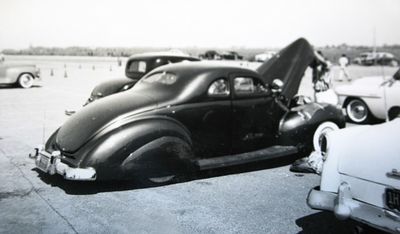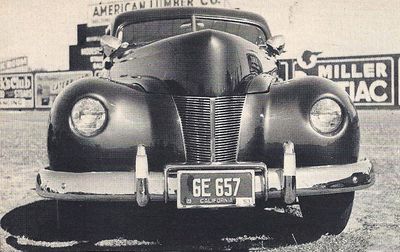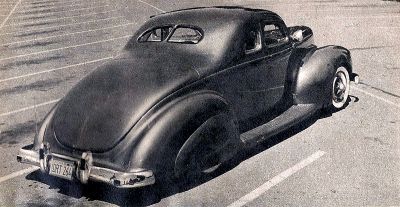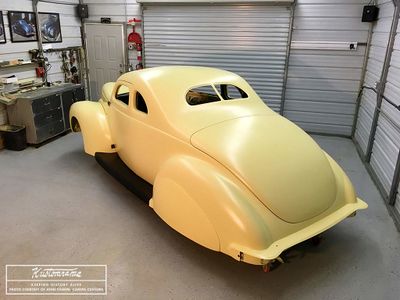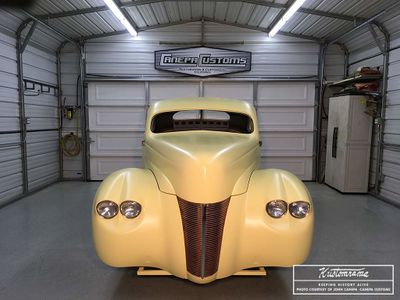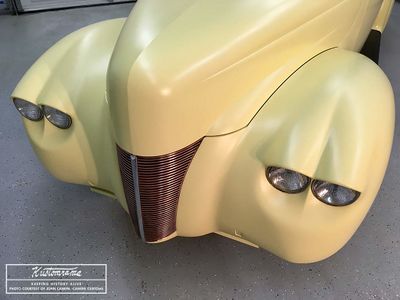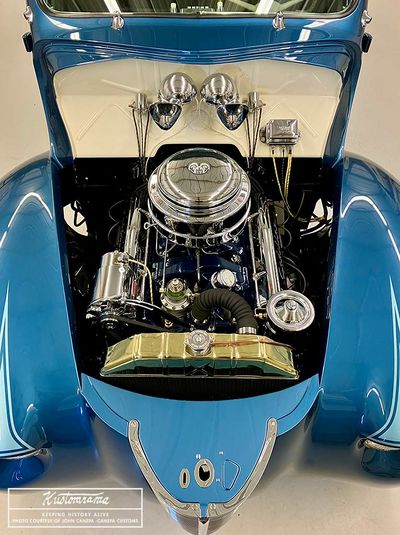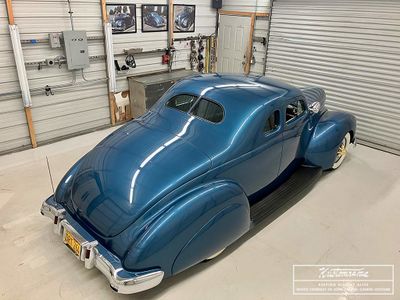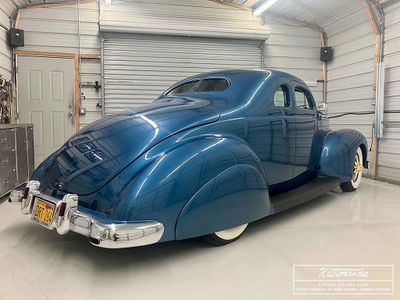Tom Hocker's 1940 Ford Coupe
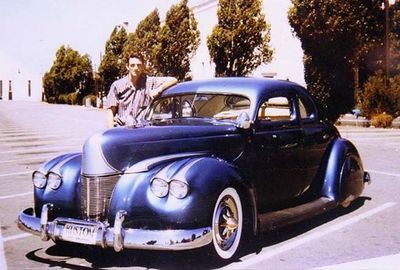
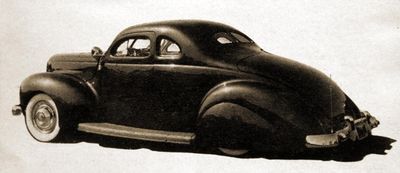
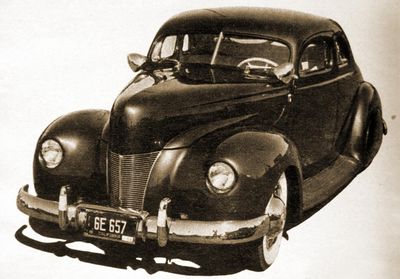

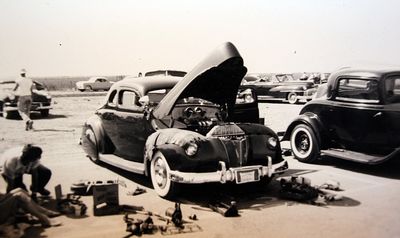




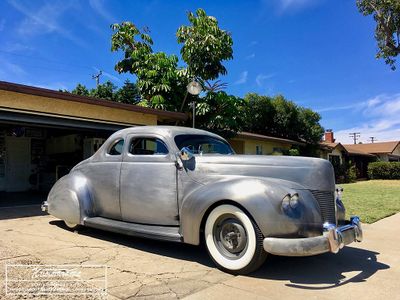



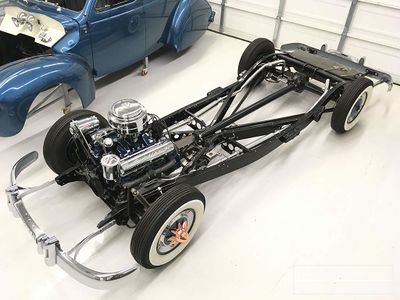


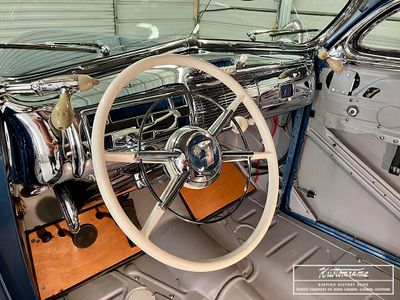


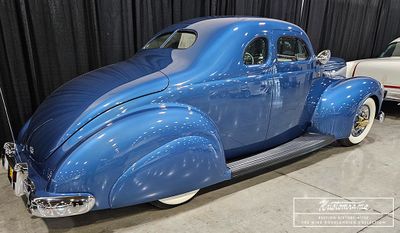
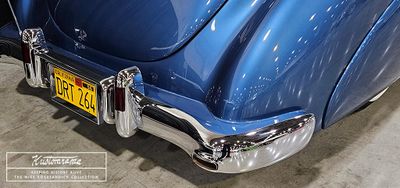
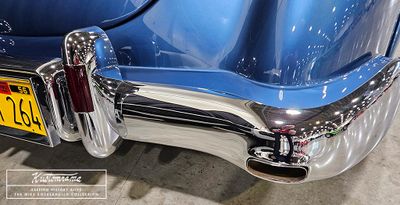
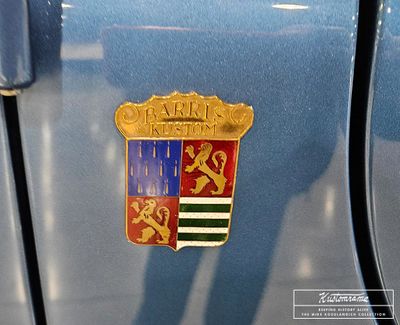


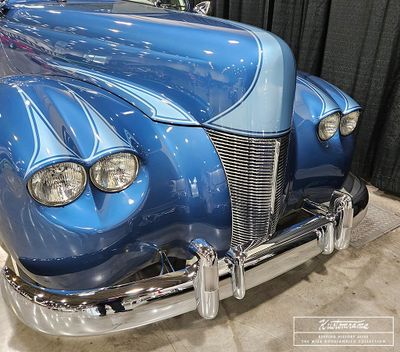
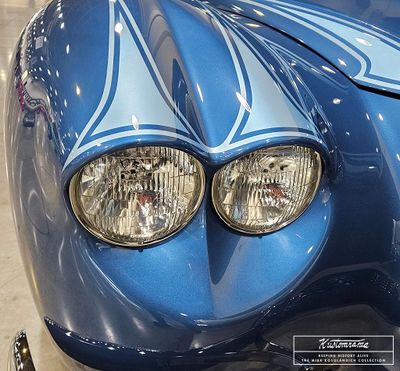
1940 Ford Coupe owned by Kustoms of Los Angeles member Tom Hocker of Oakland, California. The Hocker Coupe is a historically significant custom car known for its extensive modifications, its association with renowned customizers such as Barris Kustoms, and its appearance in the movie American Grafitti.
Contents
- 1 Early Modifications by Tom and his Brother
- 2 Restyled by Barris Kustoms
- 3 Interior by Carson Top Shop
- 4 Engine and Performance
- 5 Legacy and Appearances
- 6 Silver Blue Metallic With Scallops
- 7 Quad Headlights, Cadillac Power and Scallops
- 8 The American Graffitti Version
- 9 Restored by Canepa Customs
- 10 Magazine Features
- 11 References
Early Modifications by Tom and his Brother
Hocker purchased the used coupe around 1947/1948. Not long after the acquisition, he embarked on a series of transformations. The car's initial modifications included a significant lowering of its stance. With help from his brother Joe, the car was gutted from one end to another, leaving it as an empty body shell. The aft portion of the frame from the forward part of the kick-up rearward portion. The rear part of the frame was repositioned 5 inches higher to achieve this effect.[1]
Restyled by Barris Kustoms
The lowering job was not enough for Hocker. He sought further customization and approached Barris Kustoms, a renowned custom car shop in California, to continue the build. Under the guidance of Sam and George Barris, the car underwent a series of aesthetic enhancements. The top was chopped 2 & 3/4" in front and 2.5" in the rear. The windshield was leaned back, and the rear window was leaned forward. During the chop, the rear upper corners of the doors were rounded, and the drip moldings removed. The exterior was stripped of its trim and handles, and the fenders and rear gravel pan were seamlessly molded to the body. The doors and deck lid were electrically operated by push buttons installed in the dashboard. Up front, the hood was peaked and the side grilles were replaced by solid panels which were molded to the body, leaving a much narrower and much less complicated grille. Barris fabricated new headlight rims from sheet stock which were frenched into the fenders. The parking lights were inserted in the bumper guards resting on a narrowed 1949 Pontiac bumper. In the rear, the taillights were removed, and new ones were installed in the bumper guards. The rear bumper was a 1949 Pontiac unit. The tailpipes were extended through the rear bumper. The car was fit with dual Appleton spotlights, a V-butted windshield, and Packard fender skirts.[1]
Interior by Carson Top Shop
The interior was another masterpiece. Crafted by Carson Top Shop, it featured a white and gray leatherette upholstery, chrome-plated window frames, and a luxurious floor carpet in a neutral shade. The car returned to Barris Kustoms, where the front was lowered 4 inches to match Tom's lowering job. Barris then went over the car carefully before painting it in a striking shade of fuchsia orchid.[1]
Engine and Performance
When Tom got the car back, he installed a 1948 Mercury engine with a 3.5/16-inch bore. Edelbrock manifold and headers were added, and the car got a Kong ignition and Zephyr gears. The rear end was modified with 3.54 gears, transforming the Ford into a powerful machine on the road.[1]
Legacy and Appearances
The car's fame spread rapidly. February 17-22, 1953 Tom's coupe was exhibited at the fourth annual National Roadster Show in Oakland. It graced the pages of several magazines, including Rod & Custom and Custom Cars, and the first version was featured in Rod & Custom November 1953. It also appeared in Trend Book 143 Restyle Your Car, where Tom's name was misspelled "Tom Harker."
Silver Blue Metallic With Scallops
In 1955-1956, George Barris painted the car Silver Blue Metallic with scallops. The scallops were two-tone, and the outline was slightly lighter than the inner portion. Junior Conway performed the final bodywork and paint prep before George Barris laid the paint. It was dressed up with custom hubcaps and dual spotlights that Dean Jeffries had pinstriped. The hubcap consisted of 1953 Ford caps that George installed bullets and blades from Eastern Auto on. During the restoration of the car in the 2020s, Tom's widow, Lois, told John Canepa that the reason for the blue color change was because blue was Lois’ favorite color, and Tom surprised her with a new paint job for her birthday. The original fuchsia orchid color was George’s choice on the first version of the build.[2]
Quad Headlights, Cadillac Power and Scallops
May 29 - June 2, 1957 Tom's Coupe was shown at the first annual Napa Valley Rod and Custom Show. By then, a 1956 Cadillac engine had been installed in the car. It had also been restyled further, and quad headlights had been grafted on. It was still painted Sky Mist Blue Metallic with scallops.[3] According to Lois Hocker, the reason for the quad headlights was that she and Tom were towing the car home from a show behind their daily driver, and it came unhitched and crashed into a field. The passenger side fender was damaged, and when it went back to Barris for repair, George suggested doing quads since it was the new thing. Junior told John Canepa that he remembered the car arriving and that he prepped the front end after the quads for a paint blend into the existing blue that was on it.[2]
The American Graffitti Version
Sometime in the late 1960s or early 1970s, the Hocker Coupe was repainted white and purple. This version appeared in the iconic movie American Graffiti. Later on, it was owned by Ed Hagerty.[4]
Restored by Canepa Customs
In 2018 John Canepa of Canepa Customs in Huntington Beach, California announced that he was restoring the car for the current owner Rich Hubbard. Hubbard commissioned Canepa to restore it back to how it appeared in 1957, featuring quad headlights and a scallop paint job.[2]
The original notched frame had undergone several repairs over time, so Canepa opted for a pristine 1940 Ford frame for the restoration, enhancing it with an extended X-member and reinforced panels. The crossmember was also adjusted for the ideal rear stance. Additionally, a low-mileage 1953 Cadillac 331-cubic-inch V-8, in impeccable condition, was incorporated. The restoration process was meticulous, with Canepa ensuring every detail, from the v-butted windshield to the engine bay, was addressed with precision. Tom Hocker's widow, Lois, provided information about the car to help Canepa with the restoration. Canepa painted the car himself, and it required a lot of research to get the colors just right. Junior Conway, who did all the prep work for George Barris in 1956, was very informative about the historical details of the paint jobs during that time period. The pinstriped spotlights were recreated by Steve Stanford.[5]
In late September of 2023, the restoration was nearing completion. Canepa had completed his part of the rebuild, and the car was on its way to Sean at Fat Lucky to complete the interior. Canepa posted on his Facebook page that it had been a privilege to be involved in the restoration and that he was very thankful for the experience. "It tested all of my abilities and challenged me the whole way through. Gave it my absolute best and aimed to stay as accurate as possible. Studied every photo available and was fortunate to speak with the Hocker family firsthand to learn more information and receive a large amount of historical memorabilia from Tom’s personal collection. The car went through many stages since its inception, and was in very rough shape prior to the restoration. Great to see it back in it’s former glory of the late 50's."[6]
Magazine Features
Rod & Custom November 1953
Car Craft April 1954
Custom Cars September 1957
Rod & Custom December 1957
Custom Cars January 1958
Trend Book 143 Restyle Your Car
References
- ↑ 1.0 1.1 1.2 1.3 Rod & Custom November 1953
- ↑ 2.0 2.1 2.2 John Canepa
- ↑ Napa Valley Rod and Custom Show Program
- ↑ Rik Hoving Custom Photo Archive
- ↑ Hagerty - Tom Hocker ’40 Ford is making a comeback
- ↑ Facebook: Canepa Customs
Did you enjoy this article?
Kustomrama is an encyclopedia dedicated to preserve, share and protect traditional hot rod and custom car history from all over the world.
- Help us keep history alive. For as little as 2.99 USD a month you can become a monthly supporter. Click here to learn more.
- Subscribe to our free newsletter and receive regular updates and stories from Kustomrama.
- Do you know someone who would enjoy this article? Click here to forward it.
Can you help us make this article better?
Please get in touch with us at mail@kustomrama.com if you have additional information or photos to share about Tom Hocker's 1940 Ford Coupe.
This article was made possible by:
SunTec Auto Glass - Auto Glass Services on Vintage and Classic Cars
Finding a replacement windshield, back or side glass can be a difficult task when restoring your vintage or custom classic car. It doesn't have to be though now with auto glass specialist companies like www.suntecautoglass.com. They can source OEM or OEM-equivalent glass for older makes/models; which will ensure a proper fit every time. Check them out for more details!
Do you want to see your company here? Click here for more info about how you can advertise your business on Kustomrama.

